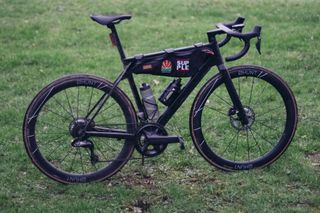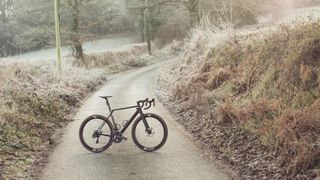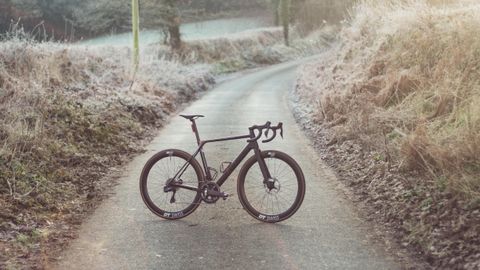Cyclingnews Verdict
An extremely competent all-around race machine. While not a full-on aero bike it can hold its own on the flats and it excels in the hills, both up and down.
Pros
- +
Beautifully balanced handling
- +
Considered aero touches
- +
Still feels like a climbers bike
Cons
- -
Still some proprietary touches
- -
Threaded BB would be preferable
- -
No 0mm seat post option
You can trust Cyclingnews
My first ‘proper’ performance road bike was a Canyon Ultimate, a third-generation model with rim brakes and a woefully unreliable Campagnolo Athena groupset. I graduated from a Specialized Allez to this fizzing carbon wasp of a bike that seemed dead set on going uphill, but it certainly wasn’t without its drawbacks. Roll on several years and I found myself throwing my leg over the new, fifth-generation Ultimate at a press camp in Nice ahead of the launch, trying to pinpoint what has changed.
Price: $6,999 / €5,799 / £6,199
Frame: Canyon Ultimate CF SLX
Size: 56cm
Weight: 7.43kg (with pedals and 2x cages)
Groupset: Shimano Ultegra Di2 w/ 4iiii power meter
Wheels: DT Swiss ARC 1400 Dicut db
Brakes: Shimano Ultegra
Bar/stem: Canyon CP0018 Aerocockpit
Seatpost: Canyon SP0055
Saddle: Selle Italia SLR Boost Superflow Titanium
While some journalists were loaned the pro-spec CFR model with its UCI-illegal weight and eye-watering price tag, I spent a few days and many roasting kilometres atop the slightly more attainable SLX 8 Di2, built with 12sp Ultegra and 50mm deep wheels. While some pangs of jealousy did pierce my heart at not riding the top-of-the-line model, the SLX, with a more general-purpose build, better represents what I think Canyon has been trying to create with this latest model; its most all-around race bike yet.
How does it ride then? How does it look, and how good is the build? I did my best to get the most out of the bike under the blazing sun on the French Riviera, but smooth tarmac and well-graded climbs never tell you the whole story. Therefore, since August of 2022 I've been putting the miles in on the Ultimate in all weathers, and on some of the best roads the UK has to offer down in Cornwall and now I'm ready to give you the whole picture, and a view on whether I think it deserves to sit amongst the best road bikes.





Design and aesthetics
During the launch, I was struck by the phrase “Canyon is a design-led company”.
I wondered if I’d misunderstood or misheard the engineer as he presented the new bike to the small crowd of journalists on the balcony as the sun set over Nice. I hadn’t misheard, I was just surprised as so often when a new bike is released the talking points are exclusively engineering driven. It looks like X because it means Y metric is better, etc. etc. ad infinitum, but here we were told that while the bike had to be lighter, more aero, more comfortable and more durable it also had to look good. It had to look like a Canyon.
The design language for the brand's performance line of road, gravel, and cyclocross bikes for me all came together with the launch of the Inflite. There had been a pretty consistent design language before this, but this is when it all came together in my head. Perhaps the head designers were big fans of Blondie, but it was clear that parallel lines are important. The seat stays mirror the downtube, and the fork mirrors the seat tube, creating an easily identifiable silhouette that permeates the whole range. The fifth-generation Ultimate is no departure from this, and since the dropping of round tubes between generations two and three, the model has seen relatively few changes from an aesthetic standpoint.
Visually speaking, the most obvious change is at the front with the use of the same one-piece bar and stem as used on the Aeroad, along with a more angular fork that not only improves aerodynamics but also increases the tyre clearance to 32mm. The fork shoulders flow into subtle sculpting at the base of the headtube/downtube junction, and the chainstays have been flattened at the dropouts.



One other nod to a more aero focus is the swap from a round to a D-shaped seatpost and seat tube, but these aero gains (10 watts for the frameset, but dropping to five with a rider on board) haven’t come at the sacrifice of the more delicate look of the frameset. While the Aeroad is clearly a purpose-driven speed machine, Canyon wishes the Ultimate to remain ‘a road bike’, and visually accessible too.
Personally, I think the look has mellowed with time through the generations, though this is probably down to the paintwork as much as anything else. I think my own gen-three had ‘CANYON’ painted on it at least 13 times, whereas now, being a much more established brand, a single wordmark on the downtube does the business.
My paintwork, a mix of black and black, with black lettering to compliment the black bars, black seatpost and black bar tape will appeal to those stealthy fans but it’s not my cup of tea. The mix of matte and gloss provided a bit of visual intrigue, but I do understand that black is a) timeless and b) easy to match with any kit. My personal favourite was the black and white as seen on the SL model, but for fans of the SLX who don’t want black, the dark purple known as ‘Iced Berry’ would be my choice of colour. There's also a rather nice gloss-finish teal colour available, known as Tarn Blue.
My main complaint with any all-black bike, especially matte black, is that they're an absolute nightmare to keep looking clean. Dust, grease, watermarks, snot etc all show up the moment the sun hits the frame or bars. I have a tendency to divert down extremely agricultural backroads when I grow weary of playing with the traffic, and as such, I do prefer at least the easier wipe clean of a gloss bike.
One final piece of design that’s worthy of discussion is the 3D-printed computer mount. At 17g it's alarmingly light thanks primarily to a lack of a heavy insert meaning you must stick to a single mounting system. Despite the low weight, I couldn’t snap it, despite a bit of flex, and it was strong enough to pop open some beers with too. However, it wasn't quite so durable long term as I'll go into.




The build
Kitting out my SLX frameset was the in-house bar-stem and seatpost (a 20mm offset model), along with in-house bar tape and new superlight bottle cages too. Atop the seatpost was a titanium-railed Selle Italia SLR Boost Superflow saddle with an extremely generous cutout.
The drivetrain was taken care of by Shimano, with 12sp Ultegra Di2 and a 4iiii crank-based power meter. A semi-compact 52/36 chainset was complemented by an 11-30 cassette to provide a relatively healthy gear range. The pedals were also Ultegra, my own choice in this case.
Finally the wheels: DT Swiss ARC 1400 50mm deep front and rear were shod in Schwalbe Pro One tan wall tyres. While not the same wheels that came out on top in our wind tunnel testing, it's heartening to know that they are at least close cousins. The build, complete with cages, computer mount, pedals, and the nifty magnetic seatpost light weighed in at 7.43kg; not enough to bother the UCI, but respectably low nonetheless.
One detail I was particularly fond of was the integrated seat post rear light. Extremely neat, and much nicer than anything with a rubber band. That stayed on permanently.


Performance
We’ve established that it looks good, weighs not very much, and is pretty handsomely equipped, but it still has to ride well. The geometry is more or less unchanged from the fourth generation, so if you like that you’ll like this; it’s between generations three and four that the major geometry tweaks can be found (longer wheelbase, slightly taller headtube, slightly slacker head angle). All minor, but all add up to a cumulative effect of a predictable, but still agile handling bike. It doesn’t have that ultra-responsive feel that borders on instability, where you worry about giving too much steering input.
Before we address the descending I need to let you in on a secret: I didn't use to like descending very much. A month after I bought my own Canyon, I crashed it off the Col du Peyresourde at 40km/h. I found the handling of the gen-3 jittery and a little unnerving, with too much emphasis on it being ‘responsive’. It took the wind out of my sails for years whenever the road pointed downhill. Happily, though, I can report that the new Ultimate is a much more pleasant companion when the road heads downhill. With the benefit of comparison to some other new releases lately, being the new Colnago V4RS and a couple that are as yet unreleased from other major brands it definitely still feels on the more responsive end of the handling spectrum, but not to the point of any unpleasantness on what you'd think of as 'normal' gradients.

My riding back in Cornwall isn't really blessed with 'normal' gradients, however, with 17% feeling distinctly shallow on some rides. When the roads dive down these steep descents, particularly if they're twisty too, the Ultimate does feel a little less self-assured than others. You need to shift your weight a bit further back when braking into corners. The tyres were, on the whole, good. Not excellent, but nothing detrimental to the overall experience. On foggy mornings on steep backroads, they did lose traction while climbing, and on the odd descent racing to catch a ferry too, but in all honesty, there are very few road tyres that shine on mud-covered roads.
My initial thoughts were that the 25mm tyres were too narrow for British tarmac and that a 28mm would be a better choice. However, I happily rode for hours on them without any great discomfort. It's more a matter of grip and cornering confidence; the agility of the frame would be more fun with tyres you could rely on a little more under hard cornering. I don't think you'd need to replace the tyres right away, but keep an eye on our list of the best road bike tyres and tee up a better set when you run through the tread.
Speaking of tyre width, it does show that the comfort of the frame is of great importance to your overall enjoyment. I recently reviewed the Ribble Ultra SL, and despite that running 28mm tyres I couldn't bear it for more than a couple of hours on the same roads, while I'd think nothing of a 130km coastal day out on the Ultimate, despite it's narrower rubber.


While the Ultimate has traditionally been the brand's lightweight bike, the aim of this generation was a much more rounded performance package. I am happy to report however that going uphill is still absolutely where the Ultimate shines, especially on particularly steep inclines. It would be odd if I said the frame was a wobbly, soupy mess, as every new bike is stiff as an overly starched shirt. The Ultimate too is a very stiff machine. When you're properly wrenching on the bars up an evil ramp it doesn't feel like you're wasting any unnecessary effort. What's more, the geometry does lead to a feeling that your weight is further forward on the bike than with others, making for a more efficient platform. I'd rather see a 0mm offset seat post, to be honest, at least as an option to spec, to bring it in line with the upper-tier CFR model. This would help even more uphill, though conversely, it would put your weight further forward for steep descents. More choice though is always better in my eyes.
When I got off the hills and was treated to a bit of flat it became clear that the Ultimate now ticks along much more happily than its predecessors. The wheels, cockpit, and the new forks that seem to also feature on the new Inflite cyclocross bike that's been spied lately all conspire to create a bike much more adept at making prolonged efforts a pleasure. Turn the hoods in as per Tadej Pogacar's bike or Remco Evenepoel's bike (or mine, I might add) and while it's not quite got the feel of a true aero bike it definitely ticks along in superb fashion. What's more, especially over the winter, it doesn't suffer nearly so much in crosswinds as the best aero bikes tend to.





The choice of a deeper set of wheels than in previous iterations is also key to this. I think it does warrant the 'all-around race bike' moniker, and as such deserves a set of all-round wheels to make the most of the experience. The top-spec opts for the lighter, but also less aero DT Swiss Mon Chasseral set, which to me would be better swapped for a more premium wheel of similar depth to what we have here. As we'll go into in the value section, in the way it's specced I think this represents a more complete race bike than the higher tier models.
In all honesty, I very much enjoyed my time with the Ultimate and I'll be sorry to see it go. It wasn't perfect but in terms of its riding characteristics, it wasn't far off. If you don't like very sharp handling it may not be the one for you, but it's certainly manageable on that front still. The out front mount wasn't hugely durable in the long term and I replaced that with a K-Edge model. Frustratingly the Canyon cockpit uses smaller bolts than has become the 'standard' leading to a less-than-optimal mounting experience. The original, superlight model never showed any signs of wavering, but being constucted from plastic it did get slightly smushed by the annoyingly small T20 bolts, and almost welded itself to them so that, upon removal, the bolt holes began to enlargen and disintegrate.
I'm not overly sold on press-fit bottom brackets, either, though to its credit this one has been absolutely faultless despite my best efforts to ensure maximum water ingress through the winter. From a consumer standpoint, I'd rather threaded though.
The saddle was comfortable enough, though a word of warning for winter rides: The cutout is so large that, should you ride through any puddles for any great length of time you will be treated to what is best described as a 'surprise bidet experience'.

Value
In this spec, the Canyon Ultimate CF SLX 8 Di2 will set you back a smidge under £6,200, which is a lot of money. I am of the opinion though that the price is justified. For that money, you get a chassis that provides beautiful racy handling, a climbing ability that's among the best out there and enough aero touches to make it more of an all-round bike than the Aeroad. Perhaps not if all you do is flat crits, but to train on and race over a variety of terrain, this would be my choice.
What's more, you get a very good set of wheels, not some in-house set, and tyres that are at least not a detriment to the overall experience; they don't feel like a cost-cutting move. Your groupset, in the form of Ultegra Di2, is near faultless, and from an amateur perspective, even the keenest of part-time racers will struggle to justify needing the marginal gains that Dura-Ace would bring. What's more, you get a power meter too.
And I know it isn't designed for it at all, but if you're into being a silly goose you could even slap on some 32mm tyres and win gravel worlds on one. While it's not designed to be used off-road, the fact that it can win gravel races, as well as bearing a striking resemblance to the new Inflite in many ways points to an all-road versatility that I would have loved to spend more time investigating. So yes, it's lots of money, but you get a lot of bike for your cash, more so than from other options I'd say.

Verdict
What we have here in the latest Canyon Ultimate is a well rounded, well handling race bike. It definitely retains the slightly waspish feel of a race bike, but it's had a dash of aero sauce thrown into the melting pot which, along with some subtle tweaks have given it a maturity it has lacked before.
Great riding, well appointed, and actually good value too if you want an all round race and training package. Compared to the older generations it is to my mind like making a delicious pasta sauce. This generation contains the same basic ingredients as the older versions, but it's been allowed to simmer for a bit longer, and the taste is all the better for it.
| Attributes | Notes | Rating |
|---|---|---|
| Design and aesthetics | Good looking, consistent design language and aero touches | 9/10 |
| Build | Great groupset, quality wheels and tyres, power meter. What's not to like? | 10/10 |
| Performance | There's very little it doesn't do excellently. Perhaps a little racy for some in the handling | 10/10 |
| Weight | It's not quite bothering the UCI, but it's not far off | 9/10 |
| Value | Considering the performance, groupset and the wheels it's a compelling package | 9/10 |
| Overall rating | Row 5 - Cell 1 | 92% |

Will joined the Cyclingnews team as a reviews writer in 2022, having previously written for Cyclist, BikeRadar and Advntr. He’s tried his hand at most cycling disciplines, from the standard mix of road, gravel, and mountain bike, to the more unusual like bike polo and tracklocross. He’s made his own bike frames, covered tech news from the biggest races on the planet, and published countless premium galleries thanks to his excellent photographic eye. Also, given he doesn’t ever ride indoors he’s become a real expert on foul-weather riding gear. His collection of bikes is a real smorgasbord, with everything from vintage-style steel tourers through to superlight flat bar hill climb machines.
